Acquisition of antibody isotypes against Plasmodium falciparum blood stage antigens in a birth cohort
- PMID: 20070826
- PMCID: PMC2814092
- DOI: 10.1111/j.1365-3024.2009.01165.x
Acquisition of antibody isotypes against Plasmodium falciparum blood stage antigens in a birth cohort
Abstract
Information on the period during which infants lose their maternally derived antibodies to malaria and begin to acquire naturally their own immune responses against parasite antigens is crucial for understanding when malaria vaccines may be best administered. This study investigated the rates of decline and acquisition of serum antibody isotypes IgG1, IgG2, IgG3, IgG4, IgM and IgA to Plasmodium falciparum antigens apical membrane antigen (AMA1), merozoite surface proteins (MSP1-19, MSP2 and MSP3) in a birth cohort of 53 children living in an urban area in the Gambia, followed over the first 3 years of life (sampled at birth, 4, 9, 18 and 36 months). Antigen-specific maternally transferred antibody isotypes of all IgG subclasses were detected at birth and were almost totally depleted by 4 months of age. Acquisition of specific antibody isotypes to the antigens began with IgM, followed by IgG1 and IgA. Against the MSP2 antigen, IgG1 but not IgG3 responses were observed in the children, in contrast with the maternally derived antibodies to this antigen that were mostly IgG3. This confirms that IgG subclass responses to MSP2 are strongly dependent on age or previous malaria experience, polarized towards IgG1 early in life and to IgG3 in older exposed individuals.
Figures
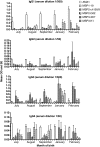
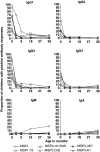
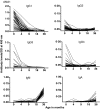
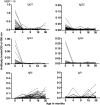
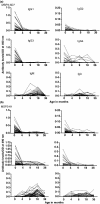
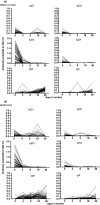
References
-
- McGregor IA. Demographic effects of malaria with special reference to the stable malaria in Africa. West Afr Med J. 1960;9:260–265.
-
- Pasvol G, Weatherall DJ, Wilson RJ. Effects of foetal haemoglobin on susceptibility of red cells to Plasmodium falciparum. Nature. 1977;270:171–173. - PubMed
-
- Edozien JC, Gilles HM, Udeozo IOK. Adult and cord-blood gamma-globulin and immunity to malaria in Nigerians. Lancet. 1962;ii:951–955.
-
- McGregor IA. Studies in the acquisition of immunity of Plasmodium falciparum infections in Africa. Trans R Soc Trop Med Hyg. 1964;58:80–92. - PubMed
Publication types
MeSH terms
Substances
Grants and funding
LinkOut - more resources
Full Text Sources
Miscellaneous

